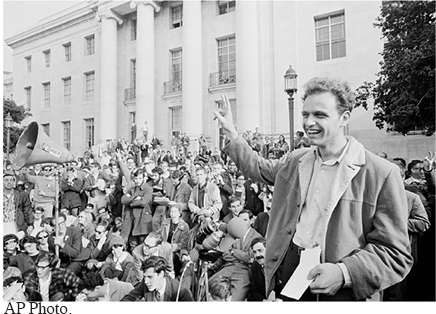Stern, The Unfree Speech Movement
This op-
THE UNFREE SPEECH MOVEMENT
SOL STERN
1
This fall the University of California at Berkeley is celebrating the 50th anniversary of the Free Speech Movement, a student-
2
Though the movement promised greater intellectual and political freedom on campus, the result has been the opposite. The great irony is that while Berkeley now honors the memory of the Free Speech Movement, it exercises more thought control over students than the hated institution that we rose up against half a century ago.
3
We early-
4
The Berkeley “machine” now promotes Free Speech Movement kitsch. The steps in front of Sproul Hall, the central administration building where more than 700 students were arrested on Dec. 2, 1964, have been renamed the Mario Savio Steps. One of the campus dining halls is called the Free Speech Movement Cafe, its walls covered with photographs and mementos of the glorious semester of struggle. The university requires freshmen to read an admiring biography of Savio, who died in 1996, written by New York University professor and Berkeley graduate Robert Cohen.
5
Yet intellectual diversity is hardly embraced. Every undergraduate undergoes a form of indoctrination with a required course on the “theoretical or analytical issues relevant to understanding race, culture, and ethnicity in American society,” administered by the university’s Division of Equity and Inclusion.
6
How did this Orwellian inversion occur? It happened in part because the Free Speech Movement’s fight for free speech was always a charade. The struggle was really about using the campus as a base for radical politics. I was a 27-
Page 169
7
During one demonstration Savio suggested that the campus cops who had arrested a protesting student were “poor policemen” who only “have a job to do.” Another student then shouted out: “Just like Eichmann.” “Yeah. Very good. It’s very, you know, like Adolf Eichmann,” Savio replied. “He had a job to do. He fit into the machinery.”
8
I realized years later that this moment may have been the beginning of the 1960s radicals’ perversion of ordinary political language, like the spelling “Amerika” or seeing hope and progress in Third World dictatorships.
9
Before that 1964–
10
The clubs had used this 40-
11
The Free Speech Movement was born on Oct. 1, 1964, when police tried to arrest a recent Berkeley graduate, Jack Weinberg, who was back on campus after a summer as a civil-
12
Mario Savio, also back from Mississippi, took off his shoes, climbed onto the roof of the police car, and launched into an impromptu speech explaining why the students had to resist the immoral new rules. Thus began months of sporadic protests, the occupation of Sproul Hall on Dec. 2 (ended by mass arrests), national media attention, and Berkeley’s eventual capitulation.
13
“But others had mastered the new world of political theater, understood the weakness of American liberalism, and soon turned their ire on the Vietnam War.”
That should have ended the matter. Savio soon left the political arena, saying that he had no interest in becoming a permanent student leader. But others had mastered the new world of political theater, understood the weakness of American liberalism, and soon turned their ire on the Vietnam War.
Page 170

14
The radical movement that the Free Speech Movement spawned eventually descended into violence and mindless anti-
15
On Oct. 1 at Berkeley, by contrast, one of the honored speakers at the Free Speech Movement anniversary rally on Sproul Plaza will be Bettina Aptheker, who is now a feminist-
16
Writing in the Berkeley alumni magazine about the anniversary, Ms. Aptheker noted that the First Amendment was “written by white, propertied men in the 18th century, who never likely imagined that it might apply to women, and/or people of color, and/or all those who were not propertied, and even, perhaps, not citizens, and/or undocumented immigrants…. In other words, freedom of speech is a Constitutional guarantee, but who gets to exercise it without the chilling restraints of censure depends very much on one’s location in the political and social cartography. We [Free Speech Movement] veterans were too young and inexperienced in 1964 to know this, but we do now, and we speak with a new awareness, a new consciousness, and a new urgency that the wisdom of a true freedom is inexorably tied to who exercises power and for what ends.” Read it and weep—
Page 171
AT ISSUE: HOW FREE SHOULD FREE SPEECH BE?
In your own words, summarize Stern’s thesis. Where does he state it?
At what point (or points) in the essay does Stern appeal to ethos? How effective is this appeal?
In paragraph 4, Stern says, “The Berkeley ‘machine’ now promotes Free Speech Movement kitsch.” First, look up the meaning of kitsch. Then, explain what Stern means by this statement.
Stern supports his points with examples drawn from his own experience. Is this enough? What other kinds of evidence could he have used?
In paragraph 5, Stern says that every undergraduate at Berkeley “undergoes a form of indoctrination.” What does he mean? Does Stern make a valid point, or is he begging the question?
Why does Stern discuss Bettina Aptheker in paragraphs 15–
16? Could he be accused of making an ad hominem attack? Why or why not?